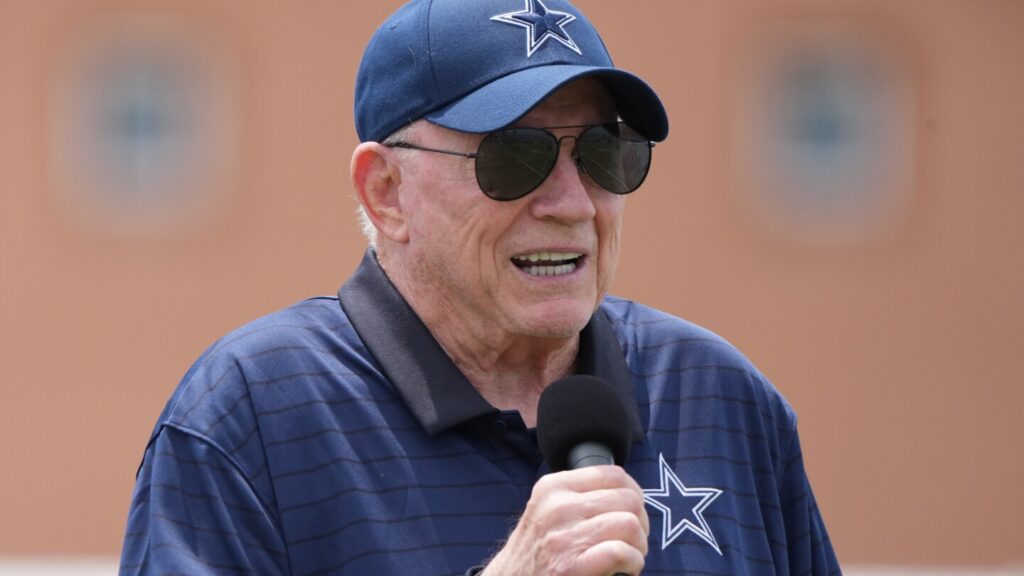The bizarre, clunky situation between the Cowboys and linebacker Micah Parsons continues to get more bizarre and more clunky.
The Cowboys believe they had a deal in place with Parsons in March, based on conversations and a supposed handshake. On Tuesday, Jones was asked about the failure to reduce to writing the deal that he believes Micah agreed to in March.
“I bought the Dallas Cowboys with a handshake,” Jones said, via Jon Machota of TheAthletic.com. “It took about 30 seconds. I gave the number, shook hands, the details we worked out later. As a matter of fact, one of the details involved a lot of money and I had to flip a coin over that. But the fundamental, ‘I’m buying and you’re gonna sell it to me for that range,’ that’s done. And those are done with eye contact and handshake.
“Just so you understand the way that I communicate with people that I negotiate with. Let’s leave it at that. There’s no question that in the case of a player contract, you have to have it in writing. All parties do. We have a contract in writing, yet we’re still talking about renegotiating, so so much for that.”
Jones has mentioned on multiple occasions the fact that Parsons already has a contract. Technically, it’s the fifth-year option that the Collective Bargaining Agreement gave the team the right to exercise.
Why does Jones keep talking about that? It’s his fallback, his safe harbor. Parsons is “under contract” for 2025, at a salary of $24 million. And Jones presumably would prefer to ride it out, forcing Parsons to carry the injury risk this year while also kicking the contract can to 2026, when the Cowboys can hold Parsons in place via the franchise tag.
Why wouldn’t Jones want to wait? At this point, the market will go no higher in 2025 than it currently is, with Steelers linebacker T.J. Watt setting the number at $41 million per year. So if the Cowboys can retain Parsons at $24 million and then pay him $41.1 million or $42 million or even $45 million per year in 2026, they will have forced him to carry the risk of a long-term injury through the full five years of his first-round rookie deal.
Teams negotiate hundreds of contracts. For the best of the best players, they negotiate two, maybe three, after accepting their take-it-or-leave-it slotted rookie deals. The best approach for the teams is to find a way to get the player to carry the risk of a career-ending (or career-limiting) injury for as long as possible. That protects the team against the rare situation in which the extra year spent under the existing deal results in the worst-case scenario that makes the player no longer as desirable as he was.
For each individual player, the chances of that happening are slim. Over time, it inevitably will happen, to someone. Which is what makes the team prefer to hedge their bets.
That’s the game Jones is currently playing. If Parsons refuses to reduce to writing the deal that Jones believes the two sides agreed to in March, then the alternative is for Parsons to play out his existing contract. That’s why Jones keeps mentioning that Micah is under contract.
The question becomes whether, when Week 1 rolls around, Parsons will accept the best offer the Cowboys will make (i.e., the contract he supposedly agreed to in March) or play out the last year of his rookie deal. If Parsons refuses to accept the team’s best offer, the question becomes whether he’ll ignore his back tightness or any other injuries and suit up and play football under the fifth year of his rookie contract.
It’s a microcosm of the broader imbalance in bargaining between management and labor. The teams know that football players want to play football. Jones is counting on Parsons wanting to play, either by accepting the team’s offer or playing for the well-below-market sum of $24 million.
And if Parsons wants more than the Cowboys will pay, the Cowboys would love nothing more than to wait until 2026 to give it to him. Or maybe until 2027. Which forces Parsons to avoid a serious injury for up to two years.
Read the full article here


